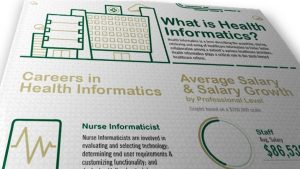The COVID-19 pandemic has impacted industries across the globe, but few like the healthcare sector. Healthcare systems have been overwhelmed and short staffed in the fight against the pandemic, but this crisis has also inspired innovation. With innovation comes challenges, and health informatics professionals are facing these challenges and turning them into opportunities for transforming the future of healthcare delivery.
Some of the most pressing challenges stand to continue as technological innovations evolve, and population health needs can change at a moment’s notice.
Five of the challenges facing health informatics are:
1. MEETING DATA MANAGEMENT TRENDS
Writing for Becker’s Hospital Review, Jackie Drees and Laura Dyrda highlight how “the pandemic underscored the need for centralized and efficient data management,” as data-gathering and reporting efforts and the adoption of online cloud storage all accelerated in 2021.
These needs and expectations for greater data information access, integration and storage capacity are only going to grow. Imaging has become more precise, creating larger file sizes and more storage capacity requirements. Artificial intelligence (AI) and data collected from medical devices must be processed to add insight to diagnoses and treatments, increasing processing demand.
IT healthcare professionals must be sure systems can adequately handle the data management needs so these technologies can function as intended. Moving to cloud-based platforms offers improved data coordination, greater systems integration potential and more secure data storage.
2. INCREASED CYBERSECURITY
The pandemic proved to be a golden opportunity for cybercriminals, as more shoppers, workers and businesses moved online. According to the FBI Internet Crime Complaint report, 800,944 cybercrime complaints were made in 2022.
Hospitals and healthcare systems have found themselves targets in this rising cybercrime wave, with multiple hospitals often targeted at once in coordinated ransomware attacks. These kinds of attacks, in which malware infects a computer and then entire system, slowing the system or blocking access until a ransom fee is paid, are the leading forms of cyberattacks, 10,666 ransomware variants were reported in 2022, compared to just 5,400 in the previous six-month period, according to the latest Global Threat Landscape Report.
The cost of these attacks on healthcare organizations can be high. Beyond the ransom to pay, there is often the loss of business, impacts to patient care if a system is shut down, loss of credibility and trust with patients and further financial hits from lawsuits. Scripps Health in San Diego paid more than a $3.5 million settlement to victims of a 2021 ransomware attack that took down its network for weeks and compromised the data information of over 147,000 patients.
3. EXPANSION OF TELEHEALTH
Once touted for its convenience and potential to increase healthcare access to those in rural areas, telehealth became a necessary healthcare technology in the midst of the COVID-19 pandemic, as lockdowns took hold and medical offices reduced capacity.
Now, patients have become accustomed to not having to trek into the office, unnecessarily expose themselves to contagious illnesses and conduct appointments from the comfort (and convenience) of their home. For those with chronic conditions, advances in remote managed care have the potential to keep patients out of the hospital or long-term care facilities, which have been severely impacted by COVID-19 outbreaks.
Telehealth is here to stay, and healthcare providers need to be prepared to meet these patient expectations and lead the development of hybrid care models. Telehealth also presents challenges, like secure connections, accessibility and technical malfunctions.
This is where health IT must understand the needs of healthcare providers and local and federal regulations, so technology is able to provide this service.
4. APPLICATION OF ARTIFICIAL INTELLIGENCE, MACHINE LEARNING AND PREDICTIVE ANALYTICS
Like so many facets of healthcare, the application of artificial intelligence (AI) and machine learning (ML) took an abrupt shift due to the COVID-19 pandemic.
While long used on the finance and operations sides of healthcare, the pandemic proved the true potential of AI and ML for predictive medicine in diagnosing illness and advising treatment plans, with a number of research institutions and health systems using it to estimate the risk of their COVID-19 patients developing severe symptoms.
Access and application of AI- and ML- derived predictive analytics has the potential to take patient care from reactive to preventative “precision medicine.” This means the potential for warning care teams of signs of patient deterioration far before a provider would normally be alerted. It may keep hospital patients out of the ICU or at-risk patients out of the hospital altogether.
All this requires the effective gathering and use of data. For example, taking collected data and “layering in” the needed data analytics tools, such as AI and ML, makes the patient data “warehouse” a source of ongoing data insights for precision medicine. These AI and ML systems will improve their “learning” with the more data they’re exposed to, underscoring the importance of data analysis from both current and future data sources—everything from patient wearables (think smart watches) to integrated biomedical devices and monitoring systems.
Healthcare’s investment in the needed technologies and analytics capabilities to integrate these diverse data sources is expected to increase. In an annual report from PwC’s Health Research Institute, nearly 75% of surveyed healthcare executives said their organizations invested more in predictive analytics and modeling for 2021, and most likely, this will be an ongoing investment.
5. ADVANCES IN ELECTRONIC HEALTH RECORDS CAPABILITIES
It can be argued that electronic health records (EHR) are the starting point of healthcare digitization when the “meaningful use” mandate required the adoption of EHR. The COVID-19 pandemic exacerbated EHR system usability and interoperability issues, speeding up the U.S. Department of Health and Human Services implementation of interoperability rules and standardization, giving patients free, secure access to their EHR.
What’s next for EHR usage, access and compliance? With the new rules, interoperability has increased between providers, payers and health tech developers, with new tools and interoperability platforms being integrated into EHR systems. Big tech players, such as Google, Amazon and Microsoft, have entered the fray as more hospitals and health systems transition to cloud platforms for hosting their EHR systems, as these offer more real-time data insights, more storage solutions and enhanced privacy and security.
Health informatics professionals will continue to lead these interoperability initiatives, learning these new tools and systems and ensuring the systems can “talk” to each other, while complying with standards for patient access and ensuring that EHRs are usable and intuitive to the clinicians treating patients. To please all parties involved and ensure these disparate systems operate in sync may be the biggest challenge of all.
PREPARING FOR THE FUTURE
2020 saw the adoption of digital health technologies in response to a global health crisis. 2021 saw the “normalization” of many of the triaged responses as the pandemic continued, emphasizing the need for scaling these technologies for improved care into the future.
Preparing to meet these challenges is integral to a health informatics professional’s success. A graduate education from USF Health’s Morsani College of Medicine can help to equip you with the knowledge to meet and overcome these challenges.




